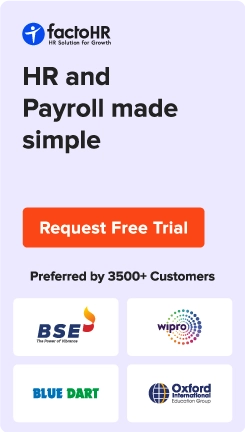10 Signs Your Business Needs a Leave Management System

Table of Contents
HR managers might find it difficult to manage an evolving workforce if they manage leave manually. Everything, from approving leave requests to tracking staff availability, would be time-consuming and lead to errors in record-keeping due to manual leave management. We aren’t listing the leaves that slipped between the cracks.
Manual leave management could also lead to other challenges such as increased absenteeism and could subsequently affect the productivity of your employees, as some or other department might be overworked. Multinational companies would find it hard to comply with the ever-evolving legal landscape of different regions.
Organizations should consider having an integrated HR software with leave management. it would be easier to monitor employee time of, which helps reduce absenteeism. Complying with different regional regulations would also be less complex, as the HR software would calculate the tax deductions and would also provide real-time updates about legislations for a particular region.
In this blog, we’ll explore 10 signs that any business needs an automated leave management system and recommend some of the must-have features for choosing the right leave management software.

How to Know if You Need a Leave Management System?
Poor leave tracking can lead to several issues, including difficulties in workforce planning, friction between employees and the organization, and a significant decline in workforce efficiency. Errors in record-keeping could also cause issues related to compliance.
A leave management system resolves all these issues by providing accurate information about available staff, streamlining the approval process, and reducing the time required for leave applications. Here are 10 signs that could lead to similar issues if not addressed promptly.
Sign #1: You’re Still Using Spreadsheets to Track Leaves
Problem: Spreadsheets aren’t ideal for performing core HR functions like leave management. You need to enter all the data manually, such as leave requests and approval status, to manage employee leaves.
Impact: HR would find it difficult to effectively contribute to strategically important functions such as decision-making, due to manual leave processing. It would also result in unintentional errors, leading to a range of issues, from compliance-related risks to increased administrative burdens on HR for re-entering all the information.
Solution: An automated leave management system streamlines the process by automatically calculating accrual balance and providing an Employee Self-Service portal (ESS) for on-the-go leave applications. An accurate and efficient leave management system is preferable to manual leave processing through spreadsheets.
Sign #2: Employees Often Complain about Leave Discrepancies
Problem: There might be frequent disputes between employees, HR, and managers due to manual leave processing. This could be because of two reasons:
- The employees aren’t well-informed about their current leave balance, and
- The managers aren’t informed on time about the approved leave requests.
Impact: Such discrepancies could result in significant issues, including decreased employee satisfaction, frequent friction between employees due to overwork, and unplanned absences, leading to workforce disruptions.
Solution: An HR solution could address these issues by providing two important features –
- Real-time access to leave balance, and
- Multi-level approval workflows for managers, where only assigned managers could approve leave requests.
Such solutions also allow employees to access detailed leave history. This creates a transparent working environment and reduces the frequency of discrepancies.
Sign #3: Managers Struggle to Approve Leaves on Time
Problem:It would be difficult for managers to approve leaves, as they need to respond to a number of correspondents. So, approving each leave request separately would be an inconvenience.
Impact: approval delays could lead to the following issues –
- Unplanned absenteeism.
- Decline in employee satisfaction, and
- Workforce disruptions.
Solution: An HR software would speed up the approval process with push notifications and automated approval workflows. For context, automated approval workflows can have more than one manager for approving leaves, which would be helpful in the absence of a reporting manager.
Sign #4: Lack of Visibility Into Your Organization’s Leave Balance
Problem: It would be harder to track the leave balance of each member, especially in a large organization, as several employees from different departments could be on leave at the same time. Manually updating the employees’ leave balances would take considerable time.
Impact: A major issue arising from this situation is the difficulty in executing tasks that require collaboration across multiple departments. This could severely impact the overall synergy of your business and potentially lead to losing clients.
Solution: It would be preferable to have a leave management system that offers total data visibility and automatically updates employee leave balances, rather than relying on spreadsheets or documents for this purpose.
Sign #5: You Face Compliance Issues during Audits
Problem: Complying with different regulations and ensuring employees are provided for leaves as per their regional regulations is a complex task, as different regions would have different regulations. A multinational firm should be aware about laws in all the countries where it has branches.
Impact: Compliance-related issues could have damaging consequences for your business. You could be penalized according to the provisions of the said regulation. Such issues could also tarnish your business’s reputation in the long run.
Solution: Advanced leave management systems provide various options for configuring leave entitlements. This allows employees to be assigned different types of leaves based on their region, as well as other criteria such as gender and position. Real-time updates and centralized HR document management help keep track of changes in a country’s laws. They also help store and access reports related to leave. This streamlines the record-keeping process and helps mitigate potential compliance risks.
Sign #6: Leave Conflicts are Causing Workforce Gaps
Problem: Leave conflicts result from approval delays and manual data entry. Workforce scheduling is essential, as it should not affect the entire team because of an individual being on leave. However, manual data entry and delays in approving leave requests make it harder to plan for potential conflicts with leave.
Impact: Disparities within the workforce could significantly impact the retention of loyal clients. For example, it would be bad for your organization’s reputation if a client needs a team member urgently, and that same team member is on leave.
Solution: An automated and integrated leave management system would be valuable for your organization. Features such as a team calendar would provide total visibility regarding staff availability, facilitating effective workforce scheduling.
Sign #7: HR Spends Too Much Time Handling Leave Requests
Problem: If you track and update all the information manually, your HR will invariably spend too much time managing leave requests. If you are a large firm with over 500 employees, managing leaves can be a lot of effort and time.
Impact: You need to consider that the HR department is increasingly becoming one of an organization’s key departments. Wasting your HR team’s valuable time on manual processes will harm your business. While others are embracing Automation, your business would become less efficient if it still relies on manual processes for leave management.
Solution: HR software would significantly reduce the time spent on leave management by automating most manual processes, such as calculating leave balances and accruals. It also streamlines the entire process with a self-service portal for submitting and tracking leave requests. Automated approval workflows help in the timely and on-the-go approval of leave requests.
Sign #8: there’s no Integration with Payroll or Attendance
Problem: One common issue when addressing leave disputes is that employees and HR disagree on the exact duration of the time off. This often happens because leave requests are processed in a document or sheet, and employee attendance is monitored and updated in another document. Another common dispute concerns the salary deducted against a Loss of Pay leave.
Impact: integration related issues could lead to larger challenges such as employee dissatisfaction. Such issues could also make it difficult for your HR to administer leave related benefits. There might be some disputes between employee, HR and managers due to errors in attendance tracking and in calculating leave balance.
Solution: An integrated HR software synchronizes data between attendance and payroll, ensuring fair employee compensation. It also provides real-time reports on leave trends and attendance patterns for efficient workforce scheduling. All in all, an integrated leave management system automates administrative tasks and facilitates data-driven decision-making.
Sign #9: Remote Teams Face Leave Communication Gaps
Problem:There was a substantial rise in the remote working population after the pandemic. Teams would find it difficult to know if a colleague is on leave, as the employee is not physically present in the office. Also, updating the team on social media might not always be desirable, as it would lead to an increased admin burden, since HR would need to enter all the data manually.
Impact: Such issues would lead to frequent workforce disruptions and wasted time due to manual leave management.
Solution: An online leave management software would be ideal for remote and hybrid workers due to its team leave calendar features and employee self-service portal. A team leave calendar would address understaffing-related issues by providing total visibility of the team’s current and upcoming leaves.
An Employee Self-Service portal would facilitate a seamless leave application process, allowing employees to apply for leave and managers to approve it in bulk. As it would be an integrated solution, it would also simplify data migrations.
Sign #10: You’ Re Scaling and Can’t Keep Up with Leave Complexity
Problem: Administering leaves for a smaller workforce is easier. Although undesirable, you can still rely on manual leave management for this task. However, as organizations evolve, managing leaves manually for a large workforce can be difficult.
Impact: This would result in several issues, including errors in leave tracking, compliance risks, and an adverse effect on organizational efficiency.
Solution: A scalable HR software should be preferred, as scalable solutions easily accommodate more employees. It would be a waste of your resources, if your chosen solution is not scalable enough to accommodate your growing workforce.

How a Leave Management System Solves these Issues
Here’s a quick recap of how automating leave management could help administer leaves effectively.
Efficiency
An integrated leave management system would streamline many operations, including accrual calculation and updating leave balances. It would also make managing payroll and monitoring employee time off easier.
Compliance
A leave management system would facilitate statutory compliance. It would provide configurable policy creations that can be tailored to various criteria, such as region and gender. It would also help with record-keeping, which is helpful during an audit.
Transparency
Employees can apply for leave, track their current leave balance, and check the approval status of their leave request on the ESS portal.
Better Workforce Planning
A team leave calendar and real-time analytics would help in workforce planning by providing visibility into current staff availability and offering details regarding leave trends.

How to Choose the Right Leave Management System?
Here are some must-have features to consider when choosing a leave management system for your company.
Integration
It is a must-have feature for any leave management system, as it automatically syncs data from various systems, such as attendance and payroll management.
Scalability
A leave management system should be scalable to accommodate an organization that is evolving. Having a leave management system that still requires HR to update all the data manually would waste considerable time and effort of your HR department. So, consider a scalable solution that can easily accommodate a large workforce.
Usability
A Human Resource Management System for leave management should be user-friendly and intuitive. Your HR department or employees should not need technical expertise to perform common operations such as policy configuration and leave application.
Mobile App
In an increasingly digitized world, a mobile app is necessary for almost every operation, and the same is true for leave management. Employees should be able to apply for leave and track their leave balance without needing an HR professional. Managers should be able to approve leave from a single portal without any hassle.

Final Thoughts
Automated leave systems are preferable over manual leave management processes. In a world driven by Automation and technological advancements, you should prefer an automated and integrated leave management system to stay relevant, efficient, and competitive.
Ask your HR department. What do they prefer? Would they like to continue managing leave manually? Or would they choose an automated leave management system? It bears repeating that leave management software would be helpful while complying with different regional regulations related to leaves. Implementing HR software would also improve your HR department’s productivity by freeing up considerable time. All in all, efficient workforce management with a leave management software would put your business in good stead.
Grow your business with factoHR today
Focus on the significant decision-making tasks, transfer all your common repetitive HR tasks to factoHR and see the things falling into their place.

© 2025 Copyright factoHR


